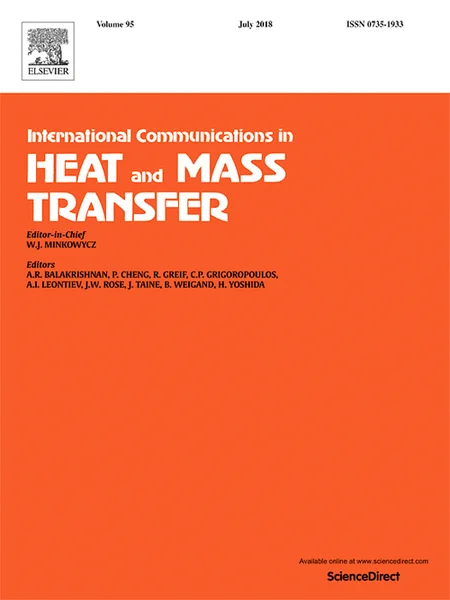-
forced turbulent heat convection in a square duct with non-uniform wall temperature
جزئیات بیشتر مقاله- تاریخ ارائه: 1397/06/10
- تاریخ انتشار در تی پی بین: 1397/06/10
- تعداد بازدید: 345
- تعداد پرسش و پاسخ ها: 0
- شماره تماس دبیرخانه رویداد: -
in the present work, the numerical simulation to calculate the problem of the turbulent convection with non-uniform wall temperature in a square cross-section duct was adopted. to solve this problem some assumptions for the flow, such as: the condition of fully developed turbulence and incompressible flow have been assumed. the methodology of the dimensionless energy equation was used to calculate the fluid temperature field in the square cross-section in function of the non-uniform wall temperatures prescribed. numerical simulations were done using two different turbulent models to resolve the momentum equations and two more models to resolve the energy equation. the models of turbulence k–ε nonlinear eddy viscosity model (nlevm) and the reynolds stress model (rsm) were used to determine the turbulent intensities as well as the profiles of axial and secondary mean velocities. the turbulence model rsm was simulated using a commercial software. the thermal field was determined from other two models: simple eddy diffusivity (sed), based in the hypothesis of the constant turbulent prandtl number; and generalized gradient diffusion hypothesis (ggdh). in this last model, as the turbulent heat transfer depends on the shear tensions, the anisotropy is considered. these two last equation models of the energy equation of the fluid have been implemented in fortran, a code of programming. the performances of the models were evaluated by validating them based in the experimental and numerical results published in the literature. two important parameters of great interest in engineering are presented: the friction factor and the nusselt number. the results of this investigation allow the evaluation of the behavior of the turbulent flow and convective heat fluxes for different square cross-sectional sections throughout the direction of the main flow, which is mainly influenced by the temperature distribution in the wall.
مقالات جدیدترین رویدادها
-
استفاده از تحلیل اهمیت-عملکرد در ارائه الگوی مدیریت خلاقیت سازمانی و ارائه راهکار جهت بهبود
-
بررسی تاثیر ارزش وجوه نقد مازاد بر ساختار سرمایه شرکت های پذیرفته شده در بورس اوراق بهادار تهران
-
بررسی تأثیر سطح افشای ریسک بر قرارداد بدهی شرکت های پذیرفته شده در بورس اوراق بهادار تهران
-
بررسی تأثیر رتبه بندی اعتباری مبتنی بر مدل امتیاز بازار نوظهور بر نقد شوندگی سهام با تأکید بر خصوصی سازی شرکت ها
-
تأثیر آمیخته بازاریابی پوشاک ایرانی بر تصویر ذهنی مشتری پوشاک ایرانی (هاکوپیان)
-
بازاریابی حسی: رویکرد نوین در صنعت بازاریابی
-
using jointly distributed random variables method to determination of saturated sand liquefaction reliability
-
ارائه مدل شبیه سازی برای بهینه سازی گردش مدارک کنترل پروژه
-
میوفیبروبلاستومای عقده لنفاوی در بازوی پسر بچه 13 ساله ”گزارش یک مورد“
-
برآورد بارمالی حوادث منجر به فوت در پروژه های ساختمانی شهر تهران در سال آتی
مقالات جدیدترین ژورنال ها
-
مدیریت و بررسی افسردگی دانش آموزان دختر مقطع متوسطه دوم در دروان کرونا در شهرستان دزفول
-
مدیریت و بررسی خرد سیاسی در اندیشه ی فردوسی در ادب ایران
-
واکاوی و مدیریت توصیفی قلمدان(جاکلیدی)ضریح در موزه آستان قدس رضوی
-
بررسی تاثیر خلاقیت، دانش و انگیزه کارکنان بر پیشنهادات نوآورانه کارکنان ( مورد مطالعه: هتل های 3 و 4 ستاره استان کرمان)
-
بررسی تاثیر کیفیت سیستم های اطلاعاتی بر تصمیم گیری موفق در شرکتهای تولیدی استان اصفهان (مورد مطالعه: مدیران شرکتهای تولیدی استان اصفهان)
-
تحلیل حکم حکومتی در فقه سیاسی
-
پنهان کاری در انتقال داده های پزشکی ایمن برای سیستم های مراقبت بهداشتی مبتنی بر iot
-
ارتباط کوته بینی مدیران با نوسانات سود و سهامداران عمده در شرکت های پذیرفته شده در بورس اوراق بهادار تهران
-
ارائه الگوی مدیریت استعداد در نهاجا
-
utilization of palm oil fuel ash and eggshell powder as partial cement replacement - a review




سوال خود را در مورد این مقاله مطرح نمایید :